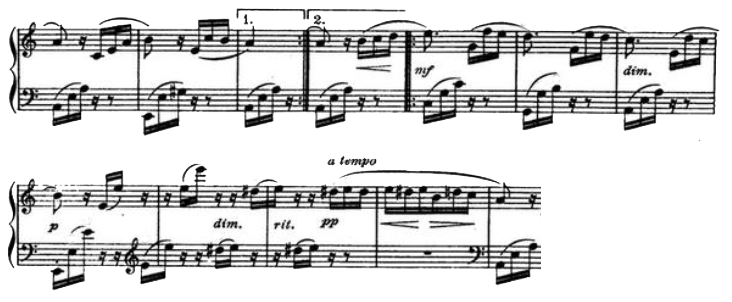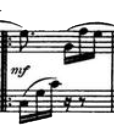Online Piano Lesson: Play Fur Elise – Lesson 3
How to Play Fur Elise – Online Piano Lesson 3
Hello everyone.
In today’s video lesson we will finish learning how to play the first movement of Fur Elise. In case you need to review, here are links to the first two lessons:
Online Piano Lesson: How To Play Fur Elise – Lesson 1
Online Piano Lesson: How To Play Fur Elise – Lesson 2
If you want to watch me play Fur Elise one more time before continuing to learn the piece, you can visit this blog post: Online Piano Performance: Fur Elise.
Once again, please take your time as you go through the video. Don’t be afraid to rewind as much as you need to, and try to spend about five minutes every day with this lesson.
If you have decided that you would like to purchase the sheet music for Fur Elise, you can click on the following link: Fur Elise sheet music.
Please note that you do not need any sheet music to learn to play the piano with my videos. But for those of you that are interested I will continue to teach you how to read the sheet music in this blog post after the video lesson.
Now press play and let the learning begin:
Some Theory
Okay – it’s time to continue learning how to read the sheet music for Fur Elise.
To review staves, clefs, the 3/8 time signature, eighth and sixteenth notes, and what pp stands for visit this blog post: Online Piano Lesson: How To Play Fur Elise – Lesson 1.
For a review of the repeat symbol and quarter notes see this blog post: Online Piano Lesson: How To Play Fur Elise – Lesson 2
Now let’s take a look at the transcription of the part of Fur Elise taught in today’s video lesson:
Let’s continue to learn about the notation used in this transcription.
Note that today’s online piano lesson video begins with the measure labeled with the number 2. It actually begins with the three eighth notes from that measure on the treble staff.
Notes
Just to quickly review the types of notes we have learned, below we have a quarter note, followed by three eighth notes, followed by four sixteenth notes:
There is actually one other kind of note in the above transcription – a dotted eighth note!
There are three dotted eighth notes on the treble staff in the above transcription. See if you can find them (note that in the transcription these notes are upside down with the flag turned inward).
When a dot is placed next to a note, the duration of the note is increased by half of its value. Since half of 1/8 is 1/16, the duration of the dotted eighth note is 1/8 + 1/16 = 3/16.
In other words, the dotted eighth note is held for the same amount of time as it takes to play three sixteenth notes.
Rests
You probably also noticed the following two strange looking symbols in the above transcription:
These symbols are called rests, and they are used to indicate an interval of silence. The duration of this silence depends on the particular symbol.
The symbol on the left is an eighth rest, and the symbol on the right is a sixteenth rest.
Let’s look closely at one measure of the above transcription and do some musical mathematics to see how the notes and rests we just learned about fill out the measure.
Let’s first look on the treble staff. We have a dotted eighth note, followed by three sixteenth notes. Recall that the duration of the dotted eighth note is 3/16. This, together with the fact that the duration of each sixteenth note is 1/16, gives a total duration of 3/16 + 1/16 + 1/16 + 1/16 = 6/16 = 3/8 (hopefully you were able to reduce that last fraction). Note that this is equal to the time signature of the song.
Now let’s look at the bass staff. Here we have three sixteenth notes, followed by a sixteenth rest, followed by an eighth rest. So we have a total duration of 1/16 + 1/16 + 1/16 + 1/16 + 1/8 = 4/16 + 1/8 = 2/8 + 1/8 = 3/8.
Let’s also take a moment to look at how nicely everything is lined up when you compare the symbols on the treble and bass staffs.
The dotted eighth note on the treble staff has the same duration as the three sixteenth notes on the bass staff. Therefore the first eighth note on the treble staff is shifted over to the right so that it appears right above the sixteenth rest on the bass staff.
Dynamics
One last thing for today. Let’s talk about that symbol mf that appears between the treble and bass staffs in the above picture.
mf is an abbreviation for mezzo-forte which means “moderately loud.” So the transcriber of this version of the piece would like you to play this part of the first movement louder than the first part.
Here are all of the standard volume indications:
- p stands for piano which means “soft.”
- f stands for forte which means “loud.”
- mp stands for mezzo-piano which means “moderately soft.”
- mf stands for mezzo-forte which means “moderately loud.”
- pp stands for pianissimo which means “very soft.”
- ff stands for fortissimo which means “very loud.”
Well that is all for today. Continue practicing the first movement of Fur Elise this week.
Next week we will begin learning to play the second movement of Fur Elise which is much harder. But do not worry! As always I will be going very slowly and teaching you note by note.
If you’ve already mastered the first movement and want to move on, all 11 lessons are already available on my Lessons page here: Fur Elise Piano Lessons
And yes, I will continue to teach some theory with each lesson for those of you that are interested.
If you are interested in a more formal system of learning how to play the piano, don’t forget to read my review of the PianoForAll system here: PianoForAll review
I hope you enjoyed this online piano lesson. See you next week…
~ Steve



